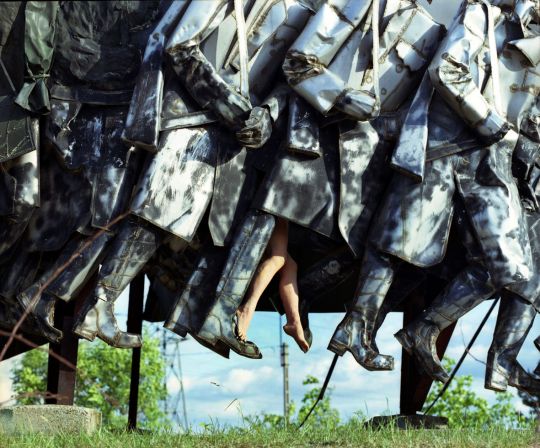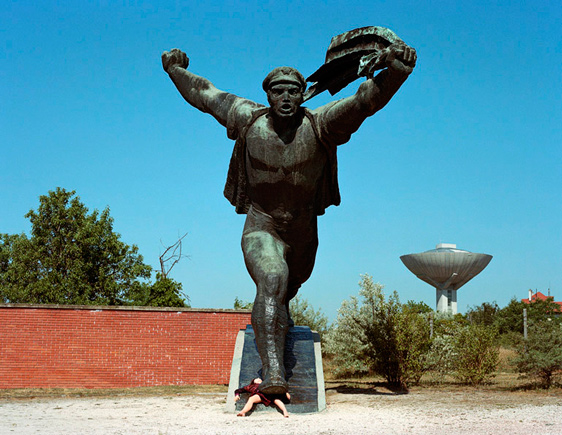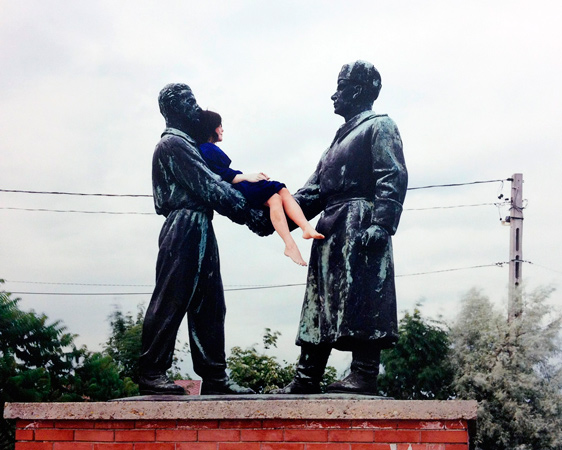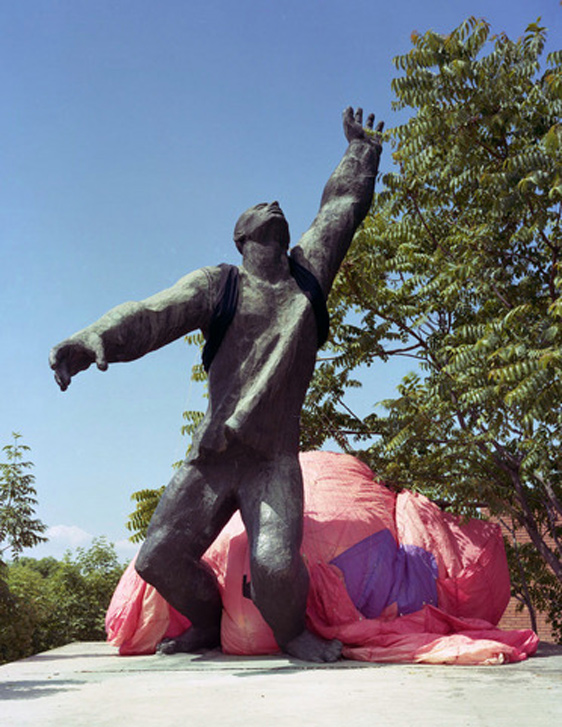The hidden meanings of Destined to be Happy exhibition - The Interview with Irina Korina
10 January 2017 | By
09 January 2017 | By
Inside the Picture: Installation Art in Three Acts - by Jane A. Sharp
19 November 2016 | By
Conversations with Andrei Monastyrski - by Sabine Hänsgen
17 November 2016 | By
Thinking Pictures | Introduction - by Jane A. Sharp
15 November 2016 | By
31 October 2016 | By
Tatlin and his objects - by James McLean
02 August 2016 | By
Housing, interior design and the Soviet woman during the Khrushchev era - by Jemimah Hudson
02 August 2016 | By
Dressing the Soviet Woman Part 3: "Are Russians Women?" Vogue on Soviet Vanity - by Waleria Dorogova
18 May 2016 | By
Dressing the Soviet Woman Part 1 - by Waleria Dorogova
13 May 2016 | By
Eisenstein's Circle: Interview With Artist Alisa Oleva
31 March 2016 | By
Mescherin and his Elektronik Orchestra - by James McLean
13 January 2016 | By
SSEES Centenary Film Festival Opening Night - A review by Georgina Saunders
27 October 2015 | By
Nijinsky's Jeux by Olivia Bašić
28 July 2015 | By
Learning the theremin by Ortino
06 July 2015 | By
Impressions of Post- Soviet Warsaw by Harriet Halsey
05 May 2015 | By
Facing the Monument: Facing the Future
11 March 2015 | By Bazarov
'Bolt' and the problem of Soviet ballet, 1931
16 February 2015 | By Ivan Sollertinsky
Some Thoughts on the Ballets Russes Abroad
16 December 2014 | By Isabel Stockholm
Last Orders for the Grand Duchy
11 December 2014 | By Bazarov
Rozanova and Malevich – Racing Towards Abstraction?
15 October 2014 | By Mollie Arbuthnot
Cold War Curios: Chasing Down Classics of Soviet Design
25 September 2014 | By
Walter Spies, Moscow 1895 – Indonesia 1942
13 August 2014 | By Bazarov
'Lenin is a Mushroom' and Other Spoofs from the Late Soviet Era
07 August 2014 | By Eugenia Ellanskaya
From Canvas to Fabric: Liubov Popova and Sonia Delaunay
29 July 2014 | By Alex Chiriac
My Communist Childhood: Growing up in Soviet Romania
21 July 2014 | By Alex Chiriac
Monumental Misconceptions: The Artist as Liberator of Forgotten Art
12 May 2014 | By Rachel Hajek
28 April 2014 | By Rachel Hajek
An Orgy Becomes a Brawl: Chagall's Illustrations for Gogol's Dead Souls
14 April 2014 | By Josephine Roulet
KINO/FILM | Stone Lithography Demonstration at the London Print Studio
08 April 2014 | By Alex Chiriac
24 March 2014 | By Renée-Claude Landry
Book review | A Mysterious Accord: 65 Maximiliana, or the Illegal Practice of Astronomy
19 March 2014 | By Rosie Rockel
Leading Ladies: Laura Knight and the Ballets Russes
10 March 2014 | By Bazarov
Exhibition Review | Cash flow: The Russian Pavilion at the 2013 Venice Biennale
03 March 2014 | By Rosie Rockel
24 February 2014 | By Ellie Pavey
Guest Blog | Pulsating Crystals
17 February 2014 | By Robert Chandler Chandler
Theatre Review | Portrait as Presence in Fortune’s Fool (1848) by Ivan Turgenev
10 February 2014 | By Bazarov
03 February 2014 | By Paul Rennie
Amazons in Australia – Unravelling Space and Place Down-Under
27 January 2014 | By Bazarov
Exhibition Review | Siberia and the East, fire and ice. A synthesis of the indigenous and the exotic
11 December 2013 | By Nina Lobanov-Rostovsky
Shostakovich: A Russian Composer?
05 December 2013 | By Bazarov
Marianne von Werefkin: Western Art – Russian Soul
05 November 2013 | By Bazarov
Chagall Self-portraits at the Musée Chagall, Nice/St Paul-de-Vence
28 September 2013 | By Bazarov
31 July 2013 | By Richard Barling
Exhibition review | Lissitsky — Kabakov: Utopia and Reality
25 April 2013 | By Richard Barling
Exhibition review | Ilya and Emilia Kabakov: The Happiest Man
18 April 2013 | By Richard Barling
12 May 2014 | By Rachel Hajek

Imagine if you will a typical Soviet-era statue (take your pick from heroic worker, soldier or leader). Among the desired emotional reactions are admiration, faith in the regime, even fear perhaps. I certainly remember feeling some of these when confronted with such statues; that is, before coming across artist Liane Lang’s work, ‘Monumental Misconceptions’.

Liane Lang, In the Way, 2009
In 2009, London-based Lang took up an artist's residency in Budapest’s Memento Sculpture Park (a resting place for discarded monumental sculptural works that were ripped down after communism fell in Hungary). While there she integrated life-size cast figures into the original bronze sculptures scattered about the park, forming what the artist refers to as ‘interventions’. These altered statues were were then photographed to produce wonderfully confusing and contemplative images. The mischievous positioning of the inserted figures throws into juxtaposition the life-size and the monumental and the (convincingly) animate and inanimate, forcing you to re-examine these historical relics in a new context. Some interventions add humour; others are subtler, adding tenderness and a touch of humanity. The female figure cradled across a handshake in in ‘Support Group’ below, entirely changes how we see what is otherwise a stern and masculine gesture.
As all 42 sculptures in the park are male and all of Lang’s figures female, I wondered if she had consciously decided to address feminist issues. When I put the question to her, she said that as a was female artist this was perhaps inescapable. She explained that it was a deliberate decision to introduce women who were very non-heroic and vulnerable, thereby heightening the contrast between intervention and statue.

Liane Lang, Support Group, 2009
During the interview I had the chance to further probe Lang’s motivations behind ‘Monumental Misconceptions’. Far from setting out to criticise communism, the artist was interested in raising the question of how context and history can influence our perception. Lang strongly believes that all art is made under the constraints dictated by the time it is made in; the constraints peculiar to Soviet-era sculpture are obvious, but she argues that there is no such thing as absolute artistic freedom even in today’s democracies. So, what then happens to an artwork's meaning once its original context has receded to the distant path? Should our treatment of it change? Lang’s work aims to set the viewer’s mind ticking along these lines, while bestowing a new context on the original Soviet sculptures.
An echo of these ideas can be found in a quote from Budapest’s Memento Sculpture Park’s architect and founder, Akos Eleod: ‘This park is about dictatorship, but as soon as it has been talked about, described and built, it is already about democracy. After all, only democracy can provide the opportunity for us to think freely about dictatorship, or about democracy, come to that, or about anything.’

Liane Lang, The Parachutist, 2009
All images are courtesy of the artist. A book based around Monumental Misconceptions titled ‘Amnesiac Patina’ will be available from 18th July 2014, and works from the series are currently on show at the Musee Beaux Arts Calais.
The exhibition runs until August 2014.Rachel Hajek


